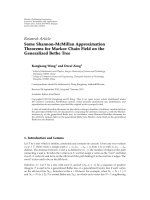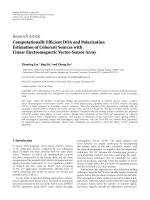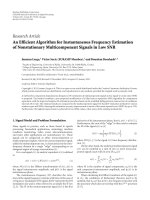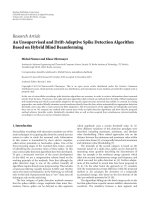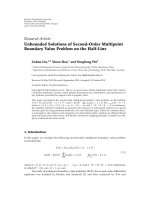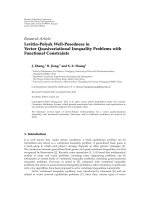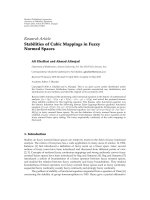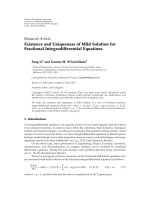Báo cáo sinh học: " Research Article Spectrally Efficient OFDMA Lattice Structure via Toroidal Waveforms on the Time-Frequency Plane" doc
Bạn đang xem bản rút gọn của tài liệu. Xem và tải ngay bản đầy đủ của tài liệu tại đây (1.11 MB, 8 trang )
Hindawi Publishing Corporation
EURASIP Journal on Advances in Signal Processing
Volume 2010, Article ID 684097, 8 pages
doi:10.1155/2010/684097
Research Article
Spect rally Efficient OFDMA Lattice Structure via Toroidal
Waveforms on the Time-Frequency Plane
Sultan Aldirmaz, Ahmet Serbes, and Lutfiye Durak-Ata (EURASIP Member)
Department of Electronics and Communications Engineering, Yildiz Technical University, Yildiz, Besiktas, 34349 Istanbul, Turkey
Correspondence should be addressed to Sultan Aldirmaz,
Received 2 January 2010; Accepted 29 June 2010
Academic Editor: L. F. Chaparro
Copyright © 2010 Sultan Aldirmaz et al. This is an open access article distributed under the Creative Commons Attribution
License, which permits unrestricted use, distribution, and reproduction in any medium, provided the original work is properly
cited.
We investigate the performance of frequency division multiplexed (FDM) signals, where multiple orthogonal Hermite-Gaussian
carriers are used to increase the bandwidth efficiency. Multiple Hermite-Gaussian functions are modulated by a data set as a
multicarrier modulation scheme in a single time-frequency region constituting toroidal waveform in a rectangular OFDMA
system. The proposed work outperforms in the sense of bandwidth efficiency compared to the transmission scheme where only
single Gaussian pulses are used as the transmission base. We investigate theoretical and simulation results of the proposed methods.
1. Introduction
As the demand for mobility and high performance in mul-
timedia services increase, efficientspectrumusagebecomes
a critical issue in wireless communications. Orthogonal
frequency division multiplexing (OFDM) is a multicarrier
modulation that has been employed by a number of current
and future wireless standards including 802.11 a/g, 802.16 a-
d, long term evolution (LTE) downlink, and next generation
networks. OFDM has been a popular method because of
its robustness in frequency selective fading characteristics
of broadband wireless systems. OFDM technology transmits
data by dividing it into parallel streams to be modulated
by subchannels each having a different carrier frequency.
Basically, data is carried on narrow-band subcarriers in
frequency domain and the carrier spacing is carefully selected
so that each subcarrier is orthogonal to the others.
Therehavebeennumerousstudiesintheliteratureto
provide efficient spectrum usage in high-performance wire-
less applications, including video streaming [1, 2]. Different
coding methods and modulation types are developed for
this task, such as hexagonal QAM structure [3, 4]. In [5],
linear combinations of Hermite-Gaussian functions are used
in the generation of two orthogonal pulse shapes to increase
the system throughput. However, such a linear combination
increases the bandwidth of a single subchannel significantly.
Pulse shape design is an important research issue because
of the corruption eects of channels, such as Doppler shifts,
fading, and noise. Conventional OFDM uses rectangular-
pulse shapes for each data. Since this pulse shape has sinc
shape in the frequency domain, its energy is dispersed to
other subcarriers when the channel is dispersive. For this
purpose, there is a ceaseless pursuit for dierent pulse shapes.
Nyquist pulses with raised cosine spectra, Hermite-Gaussian
functions based pulses [5, 6] and an optimized combination
of Slepian sequences [7–9] have been investigated in the
literature. In [7], prolate spheroidal wave functions (PSWFs)
which have maximum energy concentration within a given
time interval are used to design a time-frequency division
multiplexing (TFDM) system for multiple users. If the
transmitted pulses have maximum concentration on the
joint time-frequency (T-F) domain, then the transmitted
signal shall be preserved against the channel affects better.
Intersymbol interference (ISI) and inter-carrier interference
(ICI) are the main problems of OFDM systems. When the
transmission channel is time and frequency dispersive, the
transmitted signal spreads in both domains. Thus symbols
corrupt each other. To avoid ISI and ICI, pulse shape
design and hexagonal lattice structures are introduced. In
a hexagonal lattice structure, time and frequency distances
are increased, so the spread signal may not be affected by
the other symbols. Ambiguity function (AF) is also a useful
2 EURASIP Journal on Advances in Signal Processing
d
1
d
2
d
3
d
4
d
N−3
d
N−2
d
N−1
d
N
ψ
0
(t)
ψ
1
(t)
ψ
2
(t)
ψ
3
(t)
ψ
0
(t)
ψ
1
(t)
ψ
2
(t)
ψ
3
(t)
g
1
(t)
g
N
(t)
t − f shift
t
− f shift
Channel
Bandpass
filters
Bandpass
filters
.
.
.
.
.
.
d
1
d
2
d
3
d
4
d
N−3
d
N−2
d
N−1
d
N
+
+
+
g
1,mk
(t)
g
N,mk
(t)
+∞
−∞
g
1
(t)ψ
0
(t)dt
+∞
−∞
g
1
(t)ψ
1
(t)dt
+∞
−∞
g
1
(t)ψ
2
(t)dt
+∞
−∞
g
1
(t)ψ
3
(t)dt
+∞
−∞
g
N
(t)ψ
0
(t)dt
+∞
−∞
g
N
(t)ψ
1
(t)dt
+∞
−∞
g
N
(t)ψ
2
(t)dt
+∞
−∞
g
N
(t)ψ
3
(t)dt
Figure 1: The proposed system model. Hermite-Gaussian functions are combined to form each symbol.
time-frequency tool to analyze ISI and ICI which provides us
to observe pulse spread both in time and frequency due to
the channel effects [10, 11]. In [5, 6], a linear combination
of Hermite-Gaussian functions is optimized to construct
a desired pulse shape against the Doppler affect. In [12],
Hermite functions are used in UWB communication systems
with different modulation types such as PPM, BPSK, and
pulse shape modulation. Linear combinations of Hermite
pulses of orders 0 to 3 are obtained to construct a single pulse
shape which obeys FCC constraints in [13].
In this work we propose a toroidal waveform in a
rectangular lattice structure to increase the data rate by
providing spectrum efficiency. We use a Hermite-Gaussian
function for each data to transmit and combine N of them
to form a symbol. Figure 1 presents the general framework
of the proposed system. For example, assuming a BPSK
modulated data set D
= [d
1
, d
2
, , d
N
], the proposed
algorithm generates a pulse g(t)
= d
1
ψ
0
(t)+··· +
d
i+1
ψ
i
(t)+··· + d
N
ψ
N−1
(t), where ψ
i
(t) is the ith order
Hermite-Gaussian function. As Hermite-Gaussian functions
are orthogonal to each other, the demodulation process is
carried out easily.
Hermite-Gaussian functions possess doughnut-shapes
on the time-frequency plane. Hence, the algorithm consti-
tutes a toroidal waveform structure on the time-frequency
plane. Figure 2 presents the waveform of the system in time-
frequency plane for the baseband transmission. The figure
shows time-frequency regions are occupied by Hermite-
Gaussian functions of orders i
= 0, 1, 2, 3. Therefore, linear
combinationsofthematdifferent orders constitute a toroidal
structure. Afterwards, we shift the baseband structure in both
d
4
ψ
4
(t)
d
1
ψ
1
(t)
d
2
ψ
2
(t)
d
3
ψ
3
(t)
t
f
Figure 2: Toroidal-lattice structure model of a baseband transmis-
sion signal.
time and frequency to obtain the rectangular OFDM struc-
ture. Consequently, we investigate the bandwidth efficiency
of the proposed system.
The remainder of this paper is organized as follows. In
Section 2, a preliminary is given about Hermite-Gaussian
pulses and their time-frequency localization. System model
and the receiver part are described in Section 3.The
simulation results are discussed by presenting both SNR
versus BER values for different overlapping percentages of
the signal waveforms on the lattice form in Section 4. Finally,
conclusions are drawn in Section 5.
EURASIP Journal on Advances in Signal Processing 3
0
−1
−0.5
0
0.5
1
Samples
100 200
(a)
0
−1
−0.5
0
0.5
1
Samples
100 200
(b)
0
−1
−0.5
0
0.5
1
Samples
100 200
(c)
0
−1
−0.5
0
0.5
1
Samples
100 200
(d)
Figure 3: (a) 0th-order, (b) 1st-order, (c) 2nd-order and (d) 3rd-order Hermite-Gaussian pulses in time domain.
2. Preliminaries
2.1. Hermite-Gaussian Functions. The Hermite-Gaussian
functions span the Hilbert space L
2
(R)ofsquare-summable
functions. They are well localized in both time and frequency
domains. These functions are defined by a Hermite polyno-
mial modulated with a Gaussian function as
ψ
k
(
t
)
=
2
1/4
2
k
k!
H
k
√
2πt
e
−πt
2
,(1)
where H
k
(t) are the Hermite polynomial series that are
expressed by
H
k
(
t
)
=
(
−1
)
k
e
t
2
d
k
dt
k
e
−t
2
. (2)
AfewHermitepolynomialsareasfollows:
H
0
(
t
)
= 1, H
1
(
t
)
= 2t,
H
2
(
t
)
= 4t
2
− 2, H
3
(
t
)
= 8t
3
− 12t,
(3)
Hermite functions are orthogonal to each other, that is, [14,
page 40]
ψ
m
(
t
)
ψ
n
(
t
)
dt
=
⎧
⎨
⎩
1, m = n,
0, m
/
=n.
(4)
Figure 3 shows ψ
0
(t), ψ
1
(t), ψ
2
(t), and ψ
3
(t), respectively.
2.2. Time-Frequency Localization of Hermite-Gaussian Func-
tions. Time-frequency support of a signal x(t) can be mea-
sured by its time width and frequency domain bandwidth
as
T
x
=
t −η
t
|
x
(
t
)
|
2
dt
1/2
x
,(5)
B
x
=
f − η
f
X
f
2
d f
1/2
x
,(6)
4 EURASIP Journal on Advances in Signal Processing
t
f
F
T
Figure 4: Toroidal-rectangular OFDM lattice structure. Here, F:
frequency shift, T: time shift.
where T
x
and B
x
are time and frequency widths, respectively.
X( f ) is the Fourier transform of x(t), η
t
and η
f
are time and
frequency mean values defined by
η
t
=
t|x
(
t
)
|
2
dt
x
2
,
(7)
η
f
=
f
X
f
2
d f
x
2
,
(8)
where
·is the norm operator. Time-bandwidth product
(TBP) of a signal x(t) is defined as the product of time-
width and bandwidth as TBP
{x( t)}=T
x
B
x
. Uncertainty
principle dictates that there is a lower bound on the spread
of the energy of a signal in both time and frequency domains
together. This concentration is measured by the TBP and it is
bounded by [14, page 50]
T
x
B
x
≥
1
4π
. (9)
The zeroth-order Hermite-Gaussian function, or equiv-
alently the conventional Gaussian func tion, is the best
localized function in both time and frequency domain having
the lowest TBP equal to 1/(4π).
3. The System Model
3.1. Toroidal-Rectangular Lattice Structure. The proposed
system model is considered as an OFDM system using a
composite of different orders of Hermite-Gaussian functions
to constitute a toroidal-waveform. Hermite-Gaussians are
modulated by the data forming a toroidal lattice structure,
and these pulses are shifted in time and frequency domains
appropriately constructing a toroidal-rectangular lattice.
The general form of an OFDM toroidal-rectangular lat-
tice using N consecutive-order Hermite-Gaussian functions
ψ
0
, ψ
1
, ψ
2
, , ψ
N
is
s
(
t
)
=
K
k=0
M
m=0
N
i=0
d
m,k
(
i
)
ψ
i
(
t
− mT
)
exp
j2πFkt
, (10)
where k and m are frequency and time shifts, i is the order
of Hermite-Gaussian pulse, and d
m,k
(i) is the modulated
data. Without losing generality, we use N
= 4different
Hermite-Gaussian functions of orders i
= 0, 1, 2, and 3
for practical considerations and for simplicity. For example,
as the order of Hermite-Gaussian functions increase, the
sampling rate should also be increased due to the highly
oscillatory behavior of higher-order Hermite-Gaussian func-
tions. Figure 4 shows an example of the proposed toroidal-
rectangular OFDM lattice structure. The overall structure is
an MxK rectangular lattice with each rectangle sheltering
four toroidal regions. For this example, there are nine
different rectangular time-frequency regions including an
additional four different toroidal regions in each rectangle as
a total of 36 regions. This means that in a unit rectangular
time-frequency region, the system transmits four different
modulating data, which makes up a data set for a single
time-frequency region. Apart from the conventional Weyl-
Heisenberg system, the proposed algorithm produces pulses
according to the data to transmit. Namely, in case of a
BPSK system if the data to be transmitted is +1, we produce
+ψ
i
(t),otherwiseweproduce−ψ
i
(t) and add these functions
to the other Hermite-Gaussians constructed similarly. For
example, let us assume a BPSK data set D
= [1, −1, −1, 1]
to be transmitted in a single rectangular region. First, g(t)
=
ψ
0
(t) − ψ
1
(t) − ψ
2
(t)+ψ
3
(t), is produced in the baseband.
Then g(t) is shifted in time and frequency as g
m,k
(t) =
g(t − mT)exp(jk2πf
0
t), where m and k represent time
and frequency shifts, respectively. The algorithm transmits
four data symbols simultaneously in a unit time-frequency
region, so we increase the data rate carried in a single
rectangular region four times, but it is obvious that the
bandwidth of rectangular regions increases. In the following
proposition, we show that the bandwidth of these rectangular
regions increase approximately 1.63 times, which means
that the bandwidth efficiency is increased up to 2.44 times
compared to the single Gaussian pulse used as a transmission
basis in a T-F region. As we pointed out earlier Hermite-
Gaussian signals have the lowest TBP.
Proposition 1. TBP of linear combination of Hermite-
Gaussian signals of order 0 to 3 is (5
−
√
3)/2 ≈ 1.634 times
greater than the zeroth-order Hermite-Gaussian signal.
Proof. Hermite-Gaussian functions are defined as in (1)–(3).
Zeroth-order Hermite-Gaussian function is defined as
ψ
0
(
t
)
= 2
1/4
e
−πt
2
. (11)
As the time-frequency support of a signal x(t)ismeasuredby
its time domain and frequency domain bandwidths, first, we
EURASIP Journal on Advances in Signal Processing 5
Time
Frequency
−2
−2
−1
0
1
2
02
(a)
Time
Frequency
−2
−2
−1
0
1
2
02
(b)
Time
Frequency
−2
−2
−1
0
1
2
02
(c)
Time
Frequency
−2
−2
−1
0
1
2
0
2
(d)
Figure 5: WD of (a) 0th-order, (b) 1st-order, (c) 2nd-order and (d) 3rd-order Hermite pulses.
calculate the mean time value of the zeroth-order Hermite-
Gaussian function by using (7)
η
t
ψ
0
=
t
2
1/4
e
−πt
2
2
dt
1
(12)
and substitute it in (5) to find the time width as
T
x
ψ
0
=
t −η
t
ψ
0
2
2
1/4
e
−πt
2
2
dt
1/2
=
1
2
√
π
.
(13)
As Hermite-Gaussian functions are rotationally invariant in
the time-frequency plane, it is sufficient to evaluate the time-
width only for all Hermite-Gaussian signals in order to find
the TBP. The bandwidth B
x
is equal to time width T
x
,forall
ψ
k
(t). Therefore, TBP of the zeroth-order Hermite-Gaussian
signal is defined as
TBP
ψ
0
= T
x
ψ
0
B
x
ψ
0
= T
x
ψ
0
T
x
ψ
0
=
1
4π
. (14)
In the proposed algorithm, we increase the throughput
of the system by using N Hermite-Gaussian functions.
These pulses are added together to construct a toroidal
waveform. Hermite pulses for k
= 0, 1, 2, and 3 are expressed
as
ψ
0
(
t
)
= 2
1/4
e
−πt
2
,
ψ
1
(
t
)
=
2
1/4
√
2
H
1
√
2πt
e
−πt
2
=
2
1/4
√
2
2
√
2πte
−πt
2
= 2
1/4
2
√
π
te
−πt
2
,
6 EURASIP Journal on Advances in Signal Processing
ψ
2
(
t
)
=
2
1/4
√
8
H
2
√
2πt
e
−πt
2
=
2
1/4
2
√
2
8πt
2
− 2
e
−πt
2
= 2
1/4
4πt
2
− 1
√
2
e
−πt
2
,
ψ
3
(
t
)
=
2
1/4
√
48
H
3
√
2πt
e
−πt
2
=
2
1/4
4
√
3
16π
√
2πt
3
− 12
√
2πt
e
−πt
2
= 2
1/4
4π
√
2πt
3
− 3
√
2πt
√
3
e
−πt
2
,
(15)
Then, the toroidal lattice structure is the sum of
ψ
s
= ψ
0
+ ψ
1
+ ψ
2
+ ψ
3
= 2
1/4
e
−πt
2
+2
1/4
2
√
πte
−πt
2
+
4πt
2
− 1
2
1/4
e
−πt
2
+2
3/4
√
π
4πt
3
− 3t
√
3
e
−πt
2
.
(16)
The norm of the sum is equal to 2, when we add four
orthonormal signals. Its mean time value is calculated
by
η
t
ψ
s
=
∞
−∞
t
2
1/4
e
−πt
2
+2
1/4
2
√
πte
−πt
2
+
4πt
2
− 1
/2
1/4
e
−πt
2
+2
3/4
√
π
4πt
3
− 3t
/
√
3
e
−πt
2
2
dt
2
2
=
1+
√
2+
√
3
4
√
π
,
(17)
and its time width is
T
x
ψ
s
=
∞
−∞
t−
1+
√
2+
√
6
/4
√
π
2
2
1/4
e
−πt
2
+2
1/4
2
√
πte
−πt
2
+
4πt
2
−1
/2
1/4
e
−πt
2
+2
3/4
√
π
4πt
3
−3t
/
√
3
e
−πt
2
2
1/2
2
=
1
2
5 −
√
3
2π
.
(18)
As the time width is equal to the bandwidth of the signal,
TBP of the toroidal structure is
TBP
ψ
s
= T
x
B
x
ψ
s
=
5 −
√
3
8π
. (19)
TBP of ψ
s
compared to TBP of ψ
0
is calculated as
TBP
ψ
s
TBP
ψ
0
=
T
x
B
x
ψ
s
T
x
B
x
ψ
0
=
5 −
√
3
2
≈ 1.634. (20)
Consequently, we observe that the toroidal signal covers
a time-frequency region of 1.63 times the region of ψ
0
pulse.
However, since we t ransmit four pulses at a time we increase
the bandwidth efficiency by 4/1.634
≈ 2.44 times. Figures
5(a)–5(d) show the WD of zeroth, first, second, and third-
order Hermite-Gaussian functions, respectively. Note that
Figure 5 shows time-frequency representations of Hermite-
Gaussian functions, whose t ime domain representations are
plotted in Figure 3. Also, it is clear that the rectangular-
toroidal structure in Figure 4 is formed by the weighted
sums of the Hermite-Gaussian functions with respect to the
transmitted data. AF is calculated by taking the 2-D FFT of
the WD. As Hermite-Gaussian functions are symmetric both
in time and frequency, AF of these signals are equivalent to
their WD’s.
3.2. Channel Model and the Receiver Structure. The transmit-
ted signal is sent through a channel where the received signal
is modeled as
r
(
t
)
=
L
l=1
s
(
t
)
h
(
l −t
)
+ n
(
t
)
, (21)
where n(t) is the additive white Gaussian noise (AWGN) and
h(
·)isthechannelresponse.Thechannelisassumedtohave
the impulse response
h
(
t
)
=
L
p=1
α
p
e
jϕ
p
t
δ
t −D
p
, (22)
where L, ϕ,andD represent path number, Doppler spread
and delay, respectively. In simulations, both AWGN and
Rayleigh channel models are considered as the channel effect.
The proposed algorithm divides the time and frequency
domains into rectangles including toroidal regions. There-
fore the receiver part includes M multiplicative windows
to select the desired time interval and N con volutional
band-pass filters to separate frequency bands. Hence, we
filter only a single rectangular time-frequency region in
advance. Afterwards, we shift the signal to the baseband and
obtain the toroidal lattice structure which contains multiple
data. We take inner products of the toroidal-data with
EURASIP Journal on Advances in Signal Processing 7
−10 −50 5
10
10
0
10
−3
10
−2
10
−1
SNR (dB)
BER
H
0
H
1
H
2
H
3
Figure 6: BER versus SNR for Hermite-Gaussian signals with zero
to three order.
Hermite-Gaussian pulses to estimate the transmitted data by
taking advantage of orthogonality between different orders of
Hermite-Gaussian functions. Let us assume r(t)
= d
1
ψ
0
(t)+
d
2
ψ
1
(t)+d
3
ψ
2
(t)+d
4
ψ
3
(t)+n(t) b e the received toroidal
signal with AWGN n(t) after filtering in time-frequency. The
estimated data can be obtained as,
d
n
=
ψ
n
(
t
)
, r
(
t
)
=
∞
−∞
r
(
t
)
ψ
n
(
t
)
dt, (23)
for n
= 0, 1, 2, 3.
Hermite-Gaussian functions and their linear combina-
tions are orthogonal to each other. Thus, their time and
frequency shifted versions are used in the proposed OFDM
system simplifying the detection process.
4. Simulation Results
In this study, the aim is to increase the system throughput
by constructing a toroidal waveform in a rectangular lattice
structure. For this purpose, different orders of Hermite-
Gaussian pulses are BPSK modulated and they are added
together to generate the transmitted signal. The toroidal
pulse is shifted in both time and frequency to construct a
rectangular Weyl-Heisenberg system. We choose the SNR
range within [
−10, 10] dB and the average of 500 Monte-
Carlo iterations performed in all analyses. BPSK modulation
is used for the sake of simplicit y. If we choose another
modulation type such as M-QAM or QPSK, we may increase
the throughput more. However, we do not overly concern
ourselves with the modulation algorithm, since our purpose
is to show the performance of the toroidal system. To
examine the performances of different orders of Hermite-
Gaussian pulses, we have used each individual Hermite-
Gaussian as a single transmission pulse. Figure 6 presents
−10 −8 −6 −4 −202468
10
−4
10
−3
10
−2
10
−1
10
0
SNR(dB)
BER
OPR 50%
OPR 33.3%
OPR 16.6%
OPR 0%
Figure 7: BER versus SNR with different time shifts.
10
−3
10
−2
10
−1
10
0
BER
−10 −50 510
SNR (dB)
OPR
= 33% in AWGN channel
OPR
= 33% in Rayleigh channel
Figure 8: BER versus SNR for Rayleigh and AWGN channel.
the BER versus SNR curves for different orders of Hermite-
Gaussian signals. Each Hermite-Gaussian signal’s SNR versus
BER performance is approximately equal to other ones.
The performance of the proposed system is investigated
for different time distances between toroidal waveforms. We
define an overlapping-pulse ratio (OPR) between adjacent
pulses as the percentage of the overlapping pulses. It can
be seen from Figure 7 that as the time distance is increased,
or equivalently OPR is decreased, the system performance
is increased. If two symbols overlap, data rate increases
andthebandwidthisusedmoreefficiently, but the system
becomes more vulnerable. We have generated overlapping
pulses to test how robust the proposed system is. The
maximum overlap value to perfect recovery of data at the
8 EURASIP Journal on Advances in Signal Processing
receiver is found to be 50% in a noiseless environment.
Figure 7 presents the BER performance versus SNR of the
system for different OPRs. As OPR decreases, the system
performance increases. However, when OPR is small the
system performance does not alter very much. We also
simulate the system performance in a Rayleigh channel when
the Doppler frequency is 100 Hz and OPR is 33.3%.
In Figure 8, BER performance versus SNR in both
Rayleigh-fading and only-AWGN channels are shown. Only-
AWGN channel is approximately 10 dB better than the
Rayleigh-fading channel at SNR
= −2 dB in the BER-sense.
5. Conclusions
We have proposed a new toroidal waveform in a rectangular-
lattice OFDMA structure. The system includes N different-
order Hermite-Gaussian pulses. Each of these pulses is
modulated by different data, and they are combined together
to construct a toroidal structure which increases the data rate
up to N times. However, in case of a four-layer Hermite-
Gaussian toroidal structure, as the third-order function
covers almost twice the TF region compared to zeroth-order
one, the overall data rate increased more than twice. As part
of future works, system robustness against doubly dispersive
channel effects and ICI will be investigated.
Acknowledgment
The authors are supported by the Scientific and Technologi-
cal Research Council of Turkey, TUBITAK under the grant of
Project no. 105E078.
References
[1] I. Trigui, M. Siala, S. Affes,A.St
´
ephenne, and H. Boujem
ˆ
aa,
“Optimum pulse shaping for OFDM/BFDM systems operat-
ing in time varying multi-path channels,” in Proceedings of
the 50th Annual IEEE Global Telecommunications Conference
(GLOBECOM ’07), pp. 3817–3821, Washington, DC, USA,
November 2007.
[2] I. Kanaras, A. Chorti, M. R. D. Rodrigues, and I. Darwazeh,
“Spectrally efficient FDM signals: bandwidth gain at the
expense of receivercomplexity,” in Proceedings of the IEEE
International Conference on Communications (ICC ’09),pp.1–
6, Dresden, Germany, June 2009.
[3] C. D. Murphy, “High-order optimum hexagonal constella-
tions,” in Proceedings of the 11th IEEE International Sympo-
sium on Personal, Indoor and Mobile Radio Communications
(PIMRC ’00), vol. 1, pp. 143–146, September 2000.
[4] G. Xingxin, L. Mingquan, and F. Zhenming, “Asymmetric
hexagonal QAM based OFDM system,” in Proceedings of the
IEEE International Conference on Communications, Circuits
and Systems and West Sino Expositions, vol. 1, pp. 299–302,
June 2002.
[5] T. Kurt, G. K. Kurt, and A. Yongacoglu, “Throughput
enhancement in multi—carrier systems employing overlap-
ping Weyl—Heisenberg frames,” in Proceedings of the IEEE
International Conference on Communications (ICC ’09),Dres-
den, Germany, June 2009.
[6] R. Ayadi, I. Kammoun, and M. Siala, “Optimization of the
pulse shape of OFDM systems using the arrow-hurwicz algo-
rithm,” in Proceedings of the 4th IEEE International Symposium
on Wireless Communication Systems (ISWCS ’07), pp. 91–95,
October 2007.
[7] S. Senay, L. Durak, and L. F. Chaparro, “A time—frequency
division multiplexing communications system with hexagonal
lattice structure,” in Proceedings of 17th European Signal
Processing Conference (EUSIPCO ’09),Glasgow,Scotland,
August 2009.
[8] A. Vahlin and N. Holte, “Optimal finite duration pulses for
OFDM,” IEEE Transactions on Communications, vol. 44, no. 1,
pp. 10–14, 1996.
[9] D. Slepian, “Prolate spheroidal wave functions, fourier analysis
and uncertainty. V: the discrete case,” Bell System Technical
Journal, vol. 57, no. 5, pp. 1371–1430, 1978.
[10] W. Kozek and A. F. Molisch, “Nonorthogonal pulseshapes for
multicarrier communications in doubly dispersive channels,”
IEEE Journal on Selected Areas in Communications, vol. 16, no.
8, pp. 1579–1589, 1998.
[11] T. Strohmer and S. Beaver, “Optimal OFDM design for
time-frequency dispersive channels,” IEEE Transactions on
Communications, vol. 51, no. 7, pp. 1111–1122, 2003.
[12] J. A. N. da Silva and M. L. R. de Campos, “Spectrally efficient
UWB pulse shaping with application in orthogonal PSM,”
IEEE Transactions on Communications, vol. 55, no. 2, pp. 313–
322, 2007.
[13] J. Gomes and B. K. Mishra, “Orthogonal hermite pulses for
indoor communication with UWB (S-V) channel,” in Pro-
ceedings of the 1st InternationalConference on Computational
Intelligence, Communication Systems and Networks, pp. 369–
373, Indore, India, July 2009.
[14] H. M. Ozaktas, Z. Zalevski, and M. A. Kutay, The Fractional
Fourier Transform with Applications in Optics and Signal
Processing, New York, NY, USA, John Wiley & Sons, 2001.

